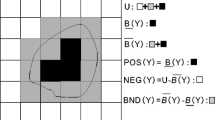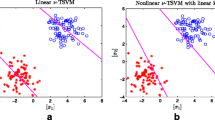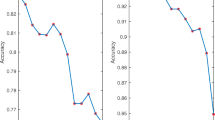Abstract
Twin support vector machine (TSVM) is a new machine learning algorithm, which aims at finding two nonparallel planes for each class. In order to do so, one needs to resolve a pair of smaller-sized quadratic programming problems (QPPs) rather than a single large one. However, when constructing the classification plane for one class, a large number of samples of this class are considered in the objective function, but only fewer samples in the other class are considered, which easily results in over-fitting problem. In addition, the same penalties are given to each misclassified samples in the TSVM. In fact, the misclassified samples have different effects on the decision of the hyper-plane. In order to overcome these two disadvantages, by introducing the rough set theory into ν-TSVM, we propose a rough margin-based ν-TSVM in this paper. In the proposed algorithm, the different points in the different positions are proposed to have different effects on the separating hyper-plane. We firstly construct rough lower margin, rough upper margin, and rough boundary in the ν-TSVM and then give the different penalties to the different misclassified samples according to their positions. The new classifier can avoid the over-fitting problem to a certain extent. Numerical experiments on one artificial dataset and six benchmark datasets demonstrate the feasibility and validity of the proposed algorithm.






Similar content being viewed by others
References
Vapnik V (1995) The nature of statistical learning theory. Springer, New York
Ripley BD (1996) Pattern recognition and neural networks. Cambridge University Press, Cambridge
Jayadeva, Khemchandani R, Chandra S (2007) Twin support vector machines for pattern classification. IEEE Trans Pattern Anal Mach Intell 29(5):905–910
Fung G, mangasarian OL (2001) Proximal support vector machine classifiers. In: Seventh international proceedings on knowledge discovery and data mining, pp 77–86
Ghorai S, Mukherjee A, Dutta PK (2009) Nonparallel plane proximal classifier. Signal Process 89(4):510–522
Fung G, mangasarian OL (2005) Multicategory proximal support vector machine classifiers. Mach Learn 59:77–97
Peng XJ (2010) A new twin support vector machine classifier and its geometric algorithms. Inf Sci 180(20):3863–3875
Kumar MA, Gopal M (2009) Least squares twin support vector machines for pattern classification. Expert Syst Appl 36(4):7535–7543
Peng XJ (2010) TSVR: an efficient twin support vector machine for regression. Neural Netw 23(3):365–372
Lin C, Wang S (2002) Fuzzy support vector machines. IEEE Trans Neural Netw 13(2):464–471
Jayadeva, Khemchandani R, Chandra S (2007) Fuzzy multi-category proximal support vector classification via generalized eigenvalues. Soft Comput 11(7):679–685
Jayadeva, Khemchandani R, Chandra S (2008) Fuzzy twin support vector machines for pattern classification. Mathematical programming and game theory for decision making. World Scientific in Singapore, pp 131–142
Kumar MA, Gopal M (2008) Application of smoothing technique on twin support vector machines. Pattern Recogn Lett 29(13):1842–1848
Ghorai S, Hossain SJ, Dutta PK, Mukherjee A (2010) Newtons method for nonparallel plane proximal classifier with unity norm hyperplanes. Signal Process 90(1):93–104
Pawlak Z (1982) Rough sets. Int J Comput Inf Sci 11:341–356
Pawlak Z (2002) Rough sets and intelligent data analysis. Inf Sci 147:1–12
Asharaf S, Shevade SK, Murty MN (2005) Rough support vector clustering. Pattern Recogn 38:1779–1783
Zhang J, Wang Y (2008) A rough margin based on support vector machine. Inf Sci 178:2204–2214
Xu YT, Wang L, Qi Z (2010) K-RSVCR: a rough margin-based multi-class support vector machine. ICIC Express Lett 4(4):1357–1362
Scholkopf B, Smola A, Bartlett P, Williamson R (2000) New support vector algorithms. Neural Comput 12(5):1207–1245
Jayadeva, Khemchandani R, Chandra S (2009) Optimal kernel selection in twin support vector machines. Optim Lett 3(1):77–88
Crisp DJ, Burges CJC (2000) A geometric interpretation of new-SVM classifiers. In: Solla S, Leen T, Muller K-R (eds) Advances in neural information processing systems, vol 12, pp 244–250
Mavroforakis ME, Theodoridis S (2007) A geometric approach to support vector machine classification. IEEE Trans Neural Netw 17(3):671–682
Acknowledgments
This work was supported by National Natural Science Foundation of China (No. 10771213) and Chinese Universities Scientific Found (No. 2010JS043). The authors gratefully acknowledge the helpful comments and suggestions of the reviewers, which have improved the presentation.
Author information
Authors and Affiliations
Corresponding author
Rights and permissions
About this article
Cite this article
Xu, Y., Wang, L. & Zhong, P. A rough margin-based ν-twin support vector machine. Neural Comput & Applic 21, 1307–1317 (2012). https://doi.org/10.1007/s00521-011-0565-y
Received:
Accepted:
Published:
Issue Date:
DOI: https://doi.org/10.1007/s00521-011-0565-y




